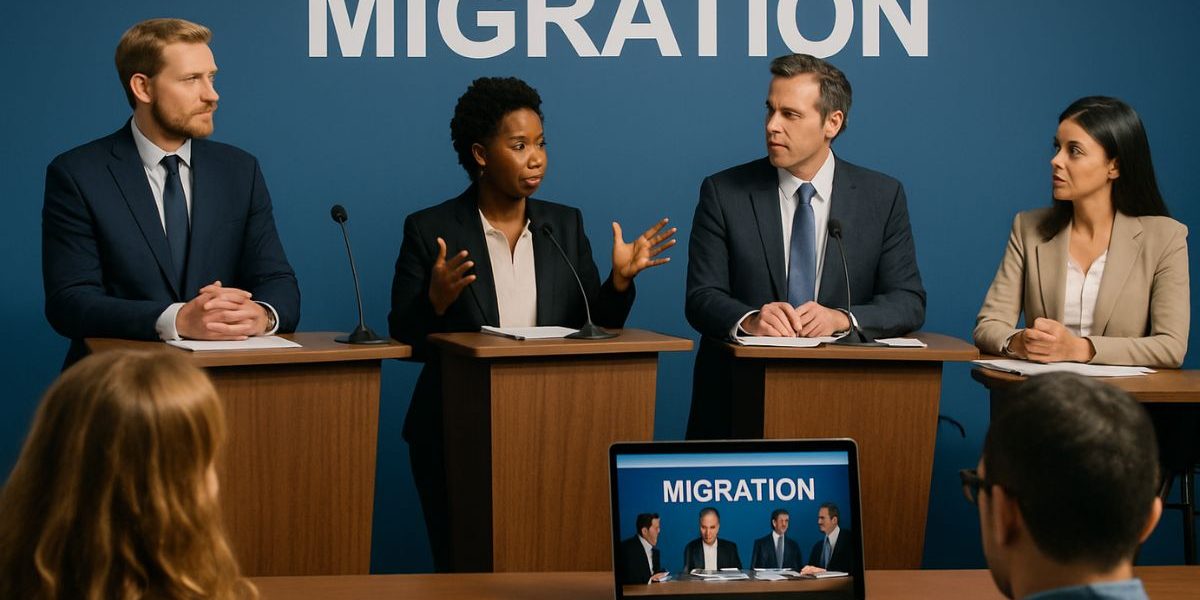Migration debates often feel less like discussions and more like battles over competing stories. The facts around immigration are complex, but the way politicians frame them can be simple, emotional, and powerful. These political narratives shape public opinion, influence policies, and impact millions of lives.
Understanding the role of political storytelling in migration debates helps us see why certain ideas catch on—and why they can be so hard to challenge. It also shows why careful, fact-based conversations about immigration are more needed than ever.
What This Article Covers
This article looks at how political narratives shape migration debates. It highlights common themes used across the political spectrum, explains how these narratives influence public perception, and discusses why separating fact from framing is essential for meaningful discussion.
How Narratives Shape Public Opinion
Humans are wired to understand the world through stories. Numbers and policies feel abstract, but stories about people—whether they are struggling migrants or communities facing economic strain—feel real. Politicians know this. That is why debates around immigration often focus less on data and more on emotion.
A story that paints migrants as hardworking contributors creates a very different public response than a story that frames them as threats. Even when both versions leave out key facts, the emotional pull can define how people think and vote.
Political narratives do not just explain immigration issues. They often simplify them, turning complex global movements into digestible headlines. And once a narrative sticks, it can be difficult to shift.
Common Themes Across Political Lines
Across different political groups, a few key themes appear again and again in migration debates. One common narrative is security. Some politicians frame immigration as a potential threat to public safety, focusing on crime, terrorism, or resource competition. These stories tap into fear and uncertainty.
Another common narrative is opportunity. Here, migrants are portrayed as people seeking a better life, bringing skills and energy to their new communities. This framing appeals to national identity as a land of opportunity and resilience.
There is also a humanitarian narrative. In this version, migration is framed as a moral issue, with a focus on protecting refugees and upholding human rights. This story appeals to compassion and global responsibility.
Each narrative can be told truthfully or misleadingly. What matters is recognizing which lens is being used—and questioning what might be left out.
How Narratives Influence Policy
The stories politicians tell about migration often shape the policies they propose. If a leader frames immigration mainly as a security threat, the resulting policies may focus on border enforcement, detention, and deportation. If immigration is framed as an economic opportunity, policies might focus more on work visas, integration programs, and education.
Narratives also influence how strictly laws are enforced, how funding is allocated, and how much flexibility exists in asylum and refugee systems. Public support for these policies often depends less on technical details and more on which story feels most convincing.
That is why the way migration is talked about during elections, news cycles, or major events can have long-term impacts far beyond the moment.
The Role of Media in Amplifying Narratives
Media outlets play a major role in shaping and spreading political narratives about migration. News coverage can choose which stories to highlight, which statistics to cite, and which voices to amplify.
Sensational headlines about border crossings or crimes involving migrants may gain more clicks than nuanced reporting on economic contributions or policy failures. Over time, this emphasis can skew public understanding.
Social media adds another layer. Short posts, viral videos, and memes can spread powerful narratives quickly—but without the context needed for critical thinking. This makes it even easier for simple stories to dominate complex debates.
Understanding how media frames migration stories helps people become more critical consumers of information—and less vulnerable to emotional manipulation.
The Importance of Fact-Based Dialogue
Migration debates deserve more than political soundbites. They deserve space for careful thought, honest data, and open-hearted discussion. Yet achieving this requires pushing beyond the dominant narratives.
It means asking hard questions. Who benefits from this story? What facts are being left out? How do real migration trends compare to the way they are portrayed?
Fact-based dialogue also means recognizing that different communities experience migration differently. One city’s needs might not match another’s. One migrant’s story might not represent millions. Respecting this complexity is part of building a conversation that is fair and grounded.
When we move past simplified narratives, we open the door to more sustainable and humane policies.
How Students and Citizens Can Respond
Challenging dominant narratives does not require shouting louder. It requires sharing better stories—stories rooted in evidence, context, and human dignity.
Students, advocates, and everyday citizens can help by reading widely, questioning assumptions, and elevating underrepresented voices. They can support journalism that digs into the realities of migration rather than leaning on fear or nostalgia.
And they can help shape new narratives. Ones that honor the real struggles and strengths of migrants. Ones that recognize the legitimate concerns of local communities without scapegoating outsiders. Ones that hold leaders accountable for telling the full story—not just the one that wins votes.
A Future Built on Better Conversations
Political narratives in migration debates are powerful—but they are not unchangeable. They reflect choices about which stories we tell and which voices we listen to.
By focusing on accuracy, empathy, and context, we can help create a public conversation that moves beyond fear and division. A conversation where policies are judged not just by how they sound, but by how they serve real people.
And that future begins with each conversation we have today.
